 Enlightened state regulators, a coalition of the willing, and continued improvements in technology together hold promise for elevating best practices around fracking to the status of new norms.
Enlightened state regulators, a coalition of the willing, and continued improvements in technology together hold promise for elevating best practices around fracking to the status of new norms.
“We’re in the first inning of a nine-inning game on the shale revolution in the United States,” Conoco CEO Ryan Lance recently boldly predicted. Given the dramatic impact of the shale revolution on the U.S., global energy and the geopolitical landscape—not to mention on declining GHG emissions—one can only hope he is correct.
But festering concerns about the environmental impact of fracking—computer-aided hydraulic fracturing and horizontal drilling—threaten both the longevity and the potential scope of the shale revolution in the U.S. and abroad.
Legitimate apprehension over methane leaks, methane flaring, water contamination, and minor earthquakes triggered by the reinjection of wastewater for disposal still hover over fracking’s future. A number of recent studies suggest, however, that the adoption of best practices by companies engaged in fracking have the capacity to ameliorate most reasonable concerns.
Some recent developments hold promise for elevating best practices to the status of new norms: a steady learning curve by state regulators who shape rules for fracking in Colorado, Wyoming, North Dakota, Ohio, and Pennsylvania; a burgeoning industry-environmentalist collaboration; and continued improvements in technology.
Progress in the States
Colorado, for example, has just approved path-breaking controls on emissions from oil and natural gas (including methane), spurred by efforts of a coalition of energy firms and environmental groups. Perhaps not coincidentally, this action follows a move by five Colorado communities to ban fracking last November. The new regulations require producers to install equipment to capture 95 percent of methane gas leaks coming from wells and pipes, while also limiting smog-producing compounds. They also require energy producers to inspect their facilities regularly and fix leaks within 15 days.
In Wyoming, as of March, a new set of regulations are in effect requiring oil and gas companies to test wells or springs within a half-mile of their drilling sites before and after drilling. The mandated rules include tests that measure temperature, bacteria, dissolved gasses such as methane and propane, nearly two-dozen chemical compounds, and elements including benzene and strontium. Another Wyoming regulation took effect last year requiring companies to monitor for air pollutants at oil and gas production sites and to fix any leaks. An environmental lawsuit heard earlier this year asks for disclosure of all chemicals used in fracking; current Wyoming rules on transparency require only partial disclosure.
Varying State Regulations
While there is clearly increased accountability and tighter regulations in moving toward best practices, it is the individual states that are responsible for much of the regulatory framework overseeing fracking. These regulations are uneven, creating a patchwork quilt of standards.
In Texas and North Dakota, the two largest oil-producing states, there are no water testing requirements; Colorado and Ohio have some requirements. Some states encourage drillers to test voluntarily. Wyoming’s new law on testing may become the gold standard and foster a new norm. And then there is the issue of capturing and reusing methane on site, now done at barely 10 percent of drilling sites.
The challenge to gaining wider public acceptance of fracking and industry-wide practices that would answer doubters in key states like New York and California is to get beyond the inconsistent patchwork of regulations. One effort to move in this direction was made by the Center for Sustainable Shale Gas Development, an organization formed last year by a coalition of energy firms and environmental groups such as the Environmental Defense Fund. The group has sought to create voluntary standards to reduce the environmental impact of fracking.
In light of an administration that has been very late to the shale party and a dysfunctional Congress, a bit of presidential leadership could go a long way in bolstering public-private partnerships to more systematically address the whole spectrum of concerns about the environmental impact of fracking.
A Way Forward
It would not be that difficult—nor require significant budgetary or Congressional action—for the President to call governors of states with major shale reserves, energy companies, environment groups, and the scientific community to the White House with the goal of forming a stakeholders commission that would examine the environmental risks, inventory, and compare current regulations. Once formed, they could be asked to issue a set of recommendations for best practices for shale oil and gas production to govern fracking across the U.S.
Such an effort could enhance safety and, at the same time, expand fracking to states that have refused to permit it. That would spur job creation and might also foster a template for other countries beginning to exploit shale oil and gas such as the U.K. and Poland.
Continuing to allow current uncertainty and ad hoc regulations (as promising as many of them are) to evolve in piecemeal fashion only risks the future of fracking and its tremendous economic benefits. We are only a few more horror stories of polluted water, methane leaks, or earthquakes away from repercussions to the fracking industry. This could be avoided if industry, environmentalists, and governments pursue their enlightened self-interests.
Robert A. Manning is a senior fellow of the Brent Scowcroft Center for International Security at the Atlantic Council and its Strategic Foresight Initiative. He served as a senior counselor to the Under Secretary of State for Global Affairs from 2001 to 2004, as a member of the US Department of State Policy Planning Staff from 2004 to 2008, and on the National Intelligence Council (NIC) Strategic Futures Group, 2008-2012.
Image: Fracking on the Haynesville Shale near Shreveport, Louisiana. (Wikimedia/Daniel Foster/CC License)
